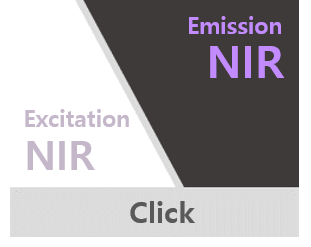
ICG ADIBO
| PACKING UNIT | price |
Lead time |
|---|---|---|
| 1 mg | $149.00 | |
| 5 mg | $441.00 | |
| 25 mg | $1,654.00 |
Description
ICG ADIBO is a strain-promoted azide-alkyne cycloaddition (SPAAC) reagent of near infrared (NIR) fluorescent dye and used to generate a stable fluorescence signal in bioimaging. NIR fluorescence allows to observe the deep image from the surface of skin and being utilized in a wide range of research fields. The maxima of Ex/Em values are at 785/812 nm. ICG might be excited using 750-800 nm laser line or LED and displays excellent optical property. ICG ADIBO couples with an azide to form 1,4-disubstituted 1,2,3-triazole inside of living systems without using any coupling reagents or catalyst nor interfering native biochemical processes. Prior to perform SPAAC, the azide functionality should be introduced onto counterpart biomolecule by means of chemical or genetic modification. We offer ICG ADIBO as a SPAAC reagent dye for cellular imaging and nucleotide functionalization.
Citation & Reference
1. Masashi Gotoh. Development of a canine model of pulmonary emphysema and imaging of the emphysematous lung with infrared thoracoscopy. J Thorac Cardiovasc Surg 126.6 (2003): 1916-21.
2. Aaron M. Mohs. An integrated widefield imaging and spectroscopy system for contrast-enhanced, image-guided resection of tumors. IEEE Trans Biomed Eng 62.5 (2015): 1416-24.
3. Mohammed Hassan. Near Infrared Fluorescence Imaging with ICG in TECAB Surgery Using the da Vinci Si Surgical System in a Canine Model. J Card Surg 27.2 (2012): 158-162.
4. R. C. Benson. Fluorescence properties of indocyanine green as related to angiography. Phys Med Biol 23.1 (1978): 159-63.
5. Mitsuharu Miwa. The Principle of ICG Fluorescence Method. The Open Surgical Oncology Journal 2 (2010): 26-28.
OPTION
Total

 log
log My
My Contact
Contact











